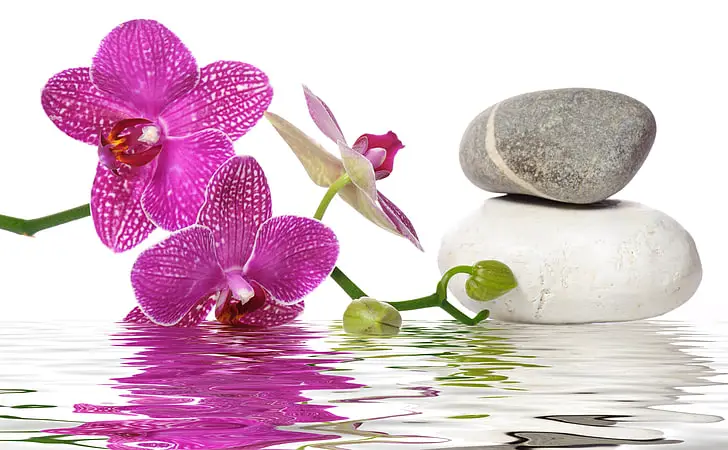 While orchids are generally easy to care for, one of the most frequent questions people have is how much do you water orchids?
While orchids are generally easy to care for, one of the most frequent questions people have is how much do you water orchids?
Orchids are a beautiful, popular type of flower that comes in many different colors and varieties.
They are often given as gifts and are a popular choice for weddings and other special occasions.
Or you may have bought one at the supermarket on a whim. So many people get an orchid with no idea how to care for it.
How Much Do You Water Orchids?
One of the most important things to remember when it comes to orchids is that they require very little water.
This can be tricky for many to remember, as most plants need to be watered regularly in order to stay healthy.
However, over-watering is one of the leading causes of problems for orchids.
If you water your orchid too often, the roots will start to rot, which can eventually lead to the death of the orchid.
But take heart it isn’t that hard to water your orchids and this article can help you get it right.
Watering Orchids
Here is a video that will help you learn how to correctly water your orchids. It’s really not that hard once you get the hang of it.
How often should you water orchids?
Though they are often seen as delicate flowers, orchids are actually quite resilient. However, they do have specific watering needs that must be met in order to thrive.
In general, orchids should be watered once a week, allowing the soil to dry out completely between waterings.
During the winter months, when growth is slow, you may need to water your orchids less frequently.
If you notice that the leaves are beginning to wilt, that is usually a sign that it is time to water the plant.
Over-watering can be just as harmful as under-watering, so it is important to strike a balance. With a little care and attention, your orchids will thrive and bring you years of enjoyment.
What are the signs of overwatering
One of the most common problems is overwatering. If you’re not sure whether you’re watering your orchid enough, there are a few telltale signs to look out for.
Firstly, the leaves will start to yellow and wilt. The flower buds may also drop off before they have a chance to bloom.
In severe cases, the roots will start to rot, and the plant will slowly die.
If you see any of these signs, it’s important to cut back on watering and allow the plant to dry out somewhat.
What are the signs of underwatering orchids?
One of the most common problems when it comes to watering orchids is underwatering.
This can be tricky to fix because the signs of underwatering aren’t always immediately apparent.
The first sign is usually that the leaves of the plant start to droop. If you see this, check the soil to see if it’s dry.
Another sign of underwatering is that the leaves start to turn yellow. If you see this, again, check the soil and give the plant a good drink if it’s dry.
Finally, if your plant stops blooming, this is also a sign that it’s not getting enough water.
If you think your plant might be underwatered, try giving it a little extra water and see if that does the trick.
Just to clarify, if you notice that your orchid’s leaves are yellowing, wilting, or drooping, this is a sign that it is not getting enough water.
On the other hand, if you see brown or mushy leaves, this is a sign of overwatering. In either case, it’s important to take action immediately.
How can you tell if your orchid needs more water?
One of the most common questions that gets asked about growing orchids is: “How can you tell if your orchid needs more water?”
The answer is actually pretty simple – just feel the potting mix. If it feels dry to the touch, then it’s time to water.
I like to water my orchids in the morning, so that they have all day to dry out before evening comes.
If you’re not sure whether the potting mix is dry enough, it’s always better to err on the side of caution and give your plant a little extra water.
Just be sure to empty out any excess water that collected in the pot after watering.
Remember though,overwatering is one of the most common mistakes made when growing orchids.
What type of water is best for orchids?
As any gardener knows, watering plants is essential for their health. But not all types of water are equally good for plants.
For example, most orchids prefer to be watered with rainwater or distilled water, or RO water rather than tap water.
This is because tap water often contains chemicals, such as chlorine, which can damage the delicate roots of an orchid.
Most tap water is has a pretty alkaline pH and orchids prefer water that is slightly acidic.
In addition, rainwater and distilled water have a lower mineral content than tap water, which is important for preventing the build-up of salts in the potting mix.
RO (reverse osmosis )water is similar to distilled water. It is important to know both contain no minerals.
So you will need to add them back with a complete orchid fertilizer.
While you can use tap water, it’s best to use distilled or rain water for your orchids.
Common advice says to let tap water stand overnight so the chlorine evaporates.
But most tap water is now treated with chloramines instead of chlorine and chloramines do not evaporate away.
How much water should you give an orchid?
One of the most common questions is, “How much water should I give my orchid?”
The answer, unfortunately, is not as straightforward as it seems.
The amount of water your orchid needs will depend on a number of factors, including the type of orchid, the size of the pot, the time of year, and the humidity level in your home.
What are some tips for watering orchids?
Orchids are beautiful, exotic flowers that can add a touch of elegance to any home.
Unlike other houseplants, however, they require special care when it comes to watering. Here are a few helpful tips:
- First, be sure to water your orchid early in the day so that the leaves have time to dry before nightfall.
- Second, always use room-temperature water, and avoid using hard water if possible.
- Third, allow the potting mix to dry out somewhat between watering.
- Fourth, don’t be afraid to experiment a bit. Every orchid is different, and you’ll quickly develop a feel for how much water your plant needs.
When watering your orchid, be sure to give it a good soaking, until water runs out of the bottom of the pot.
Then, allow the potting mix to dry out completely before watering again.
Can you over-water an orchid?
Over-watering is one of the most common mistakes made when caring for an orchid.
These delicate plants need a careful balance of water and air to thrive, and too much water can quickly lead to problems.
When an orchid is over-watered, the roots are unable to get the oxygen they need, causing them to rot.
The plant may also start to develop brown spots on the leaves, and the stem may become floppy or mushy.
If you think your orchid might be over-watered, try gently removing it from the pot.
If the roots are dark and mushy, it’s time to give your plant a chance to dry out.
Reduce watering to once a week, and be sure to let the potting mix dry out completely between watering.
Here are a few tips to keep in mind when watering your orchid:
– Be sure to water your orchid about once a week.
– Check the moisture level of the potting mix before watering, and only water if it is dry to the touch.
– Give your orchid a good soaking, until water runs out of the bottom of the pot.
– Allow the potting mix to dry out completely between waterings.
– Use distilled or rain water if possible, as it is best for orchids.
What are some common mistakes people make when watering orchids?
One of the most common mistakes people make when watering orchids is overwatering.
This can happen if you water too often, or if you give the plant too much water at once.
Overwatering can lead to root rot, which can eventually kill the plant.
Another common mistake is under-watering. This can happen if you forget to water your orchid for a while, or if you don’t give it enough water when you do water it.
Under-watering can cause the leaves to turn yellow, wilt, and droop.
How can you avoid overwatering or under-watering your orchid?
The key is to water your orchid only when the potting mix is dry to the touch. One way to tell if the mix is dry is to stick your finger in it up to the first knuckle.
If the mix feels moist, then it’s still too early to water. Once you’ve determined that the potting mix is dry, water your orchid until water runs out of the bottom of the pot.
Be sure to discard any excess water that collects in the saucer. Allow the potting mix to dry out completely before watering again.
By following these simple guidelines, you can help ensure that your orchid stays healthy and blooms for many years to come.
Can Orchids Grow In Water? Surprising Answer – Hydroponic Orchids
How Much Do You Water Orchids? Conclusion
In conclusion, watering your orchid is important, but it’s also important to not overdo it.
Be sure to check the moisture level of the potting mix before watering, and only water if it is dry to the touch.
Give your orchid a good soaking, until water runs out of the bottom of the pot.
Then wait until the pot dries out before watering again. Eventually you will get a better feel for doing this.
Watering correctly will allow you to grow happy, healthy orchids. It just takes a bit of practice so don’t be discouraged or give up.
More info: https://www.aos.org/orchids/orchid-care/how-do-i-water-my-orchid.aspx
Read more: Are Orchids Hard To Take Care Of? Easy Growth Formula
This post contains affiliate links.


